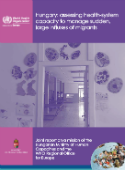Hungary: assessing health-system capacity to manage sudden, large influxes of migrants (2016)

Download
2016, viii + 22 pages
ISBN 978 92 890 5158 3
The WHO European health policy framework, Health 2020, draws particular attention to the topic of migration and health, along with other issues related to population vulnerability and human rights. Hungary has been significantly involved in a large flow of refugees, asylum seekers and migrants, the majority fleeing Afghanistan, Iraq and the Syrian Arab Republic. Hungary estimated that the 2015 population of refugees, asylum seekers and migrants was almost 400 000, representing about 33% of the 1.2 million people crossing the external borders of the European Union (EU) up to October 2015; at the time of this assessment, there were more than 360 000 migrants, among whom more than 170 000 applied for asylum. Furthermore, 80% of the arrivals in 2015 left within a few days and an additional 10% left within two weeks for other destination countries in the EU, making Hungary both a large receiving and a transit country.
This report reflects Hungary’s situation of large influxes of refugees, asylum seekers and migrants that crossed the Hungarian border prior to the border access legislation of 16 October, even as seasonal temperatures began to decline. In this context, the Hungarian Government, and specifically the State Secretariat for Health in the Ministry of Human Capacities, requested a WHO mission to support the health authorities in assessing the capacity of the Hungarian health system to manage large influxes of refugees, asylum seekers and migrants. The Ministry of Human Capacities and WHO then conducted a joint assessment from 12 to 16 October 2015 within the framework of the WHO Regional Office for Europe’s Public Health Aspects of Migration in Europe (PHAME) project, with representatives of Hungarian government and nongovernmental agencies and of international organizations as active participants.



